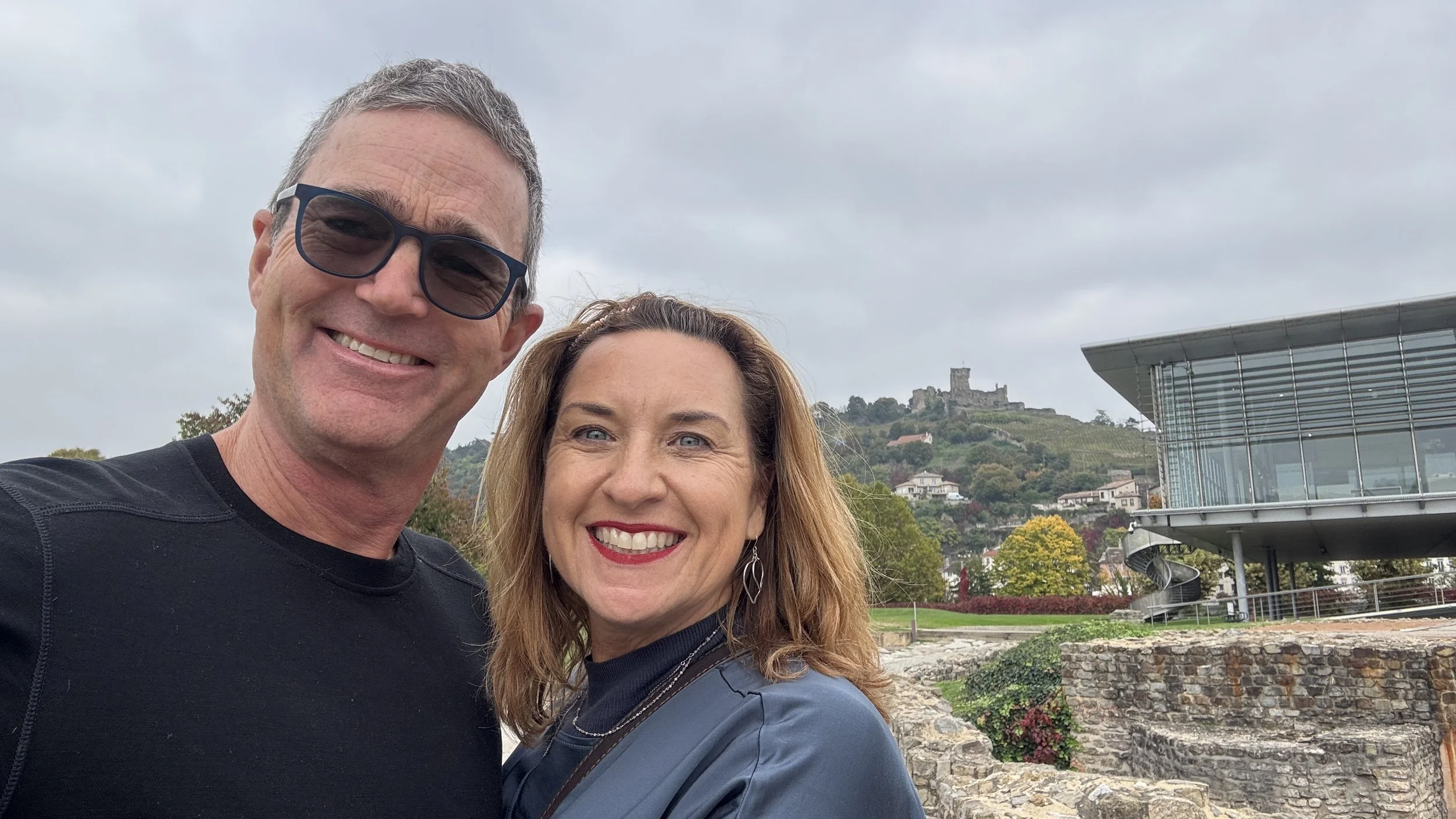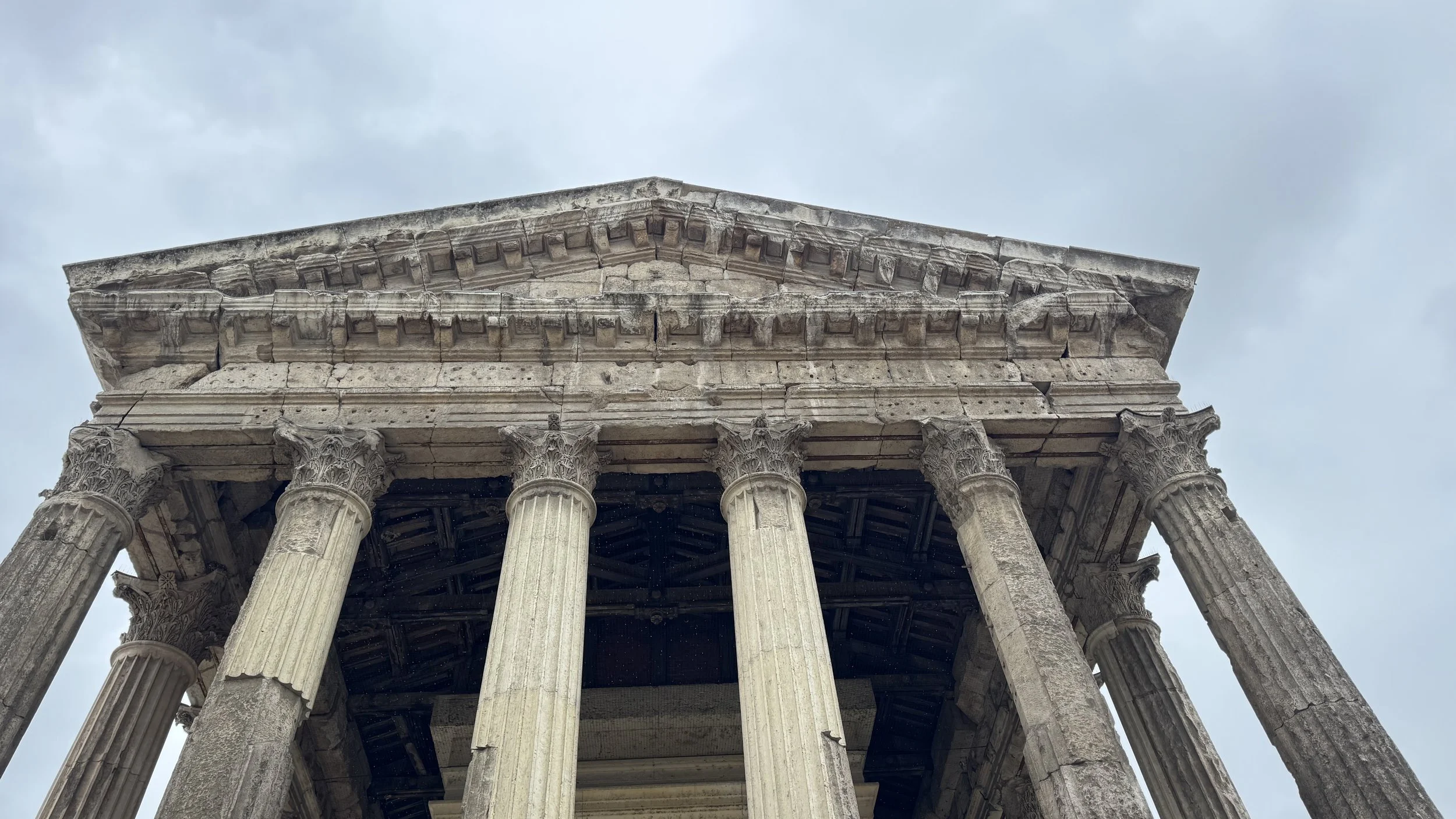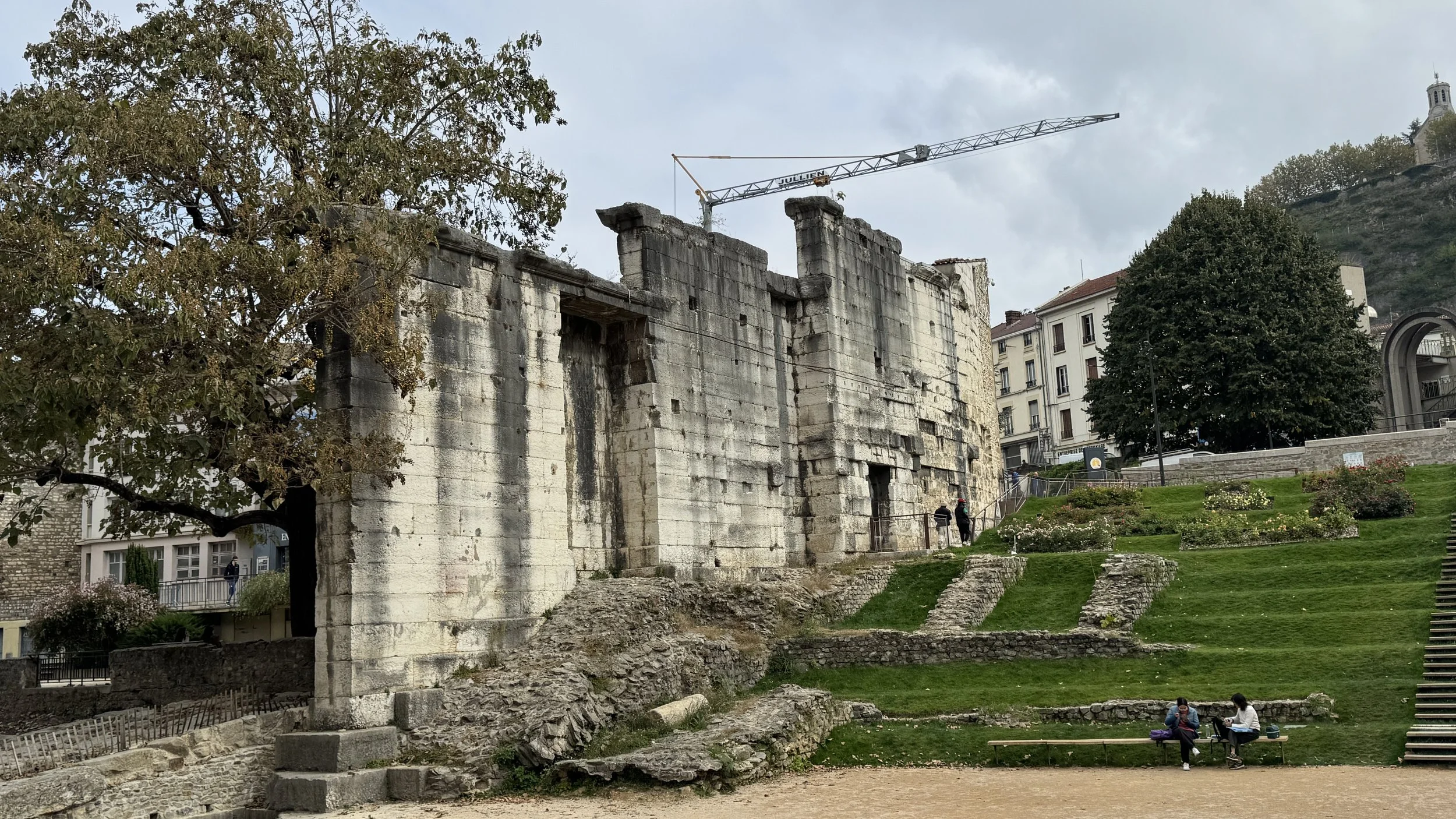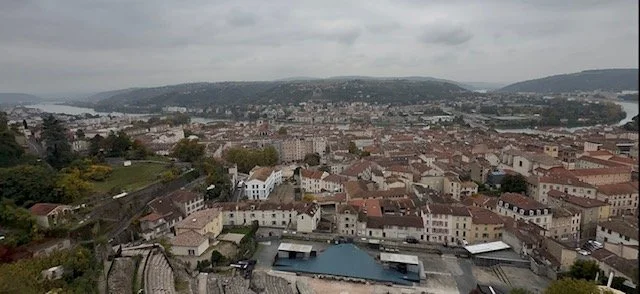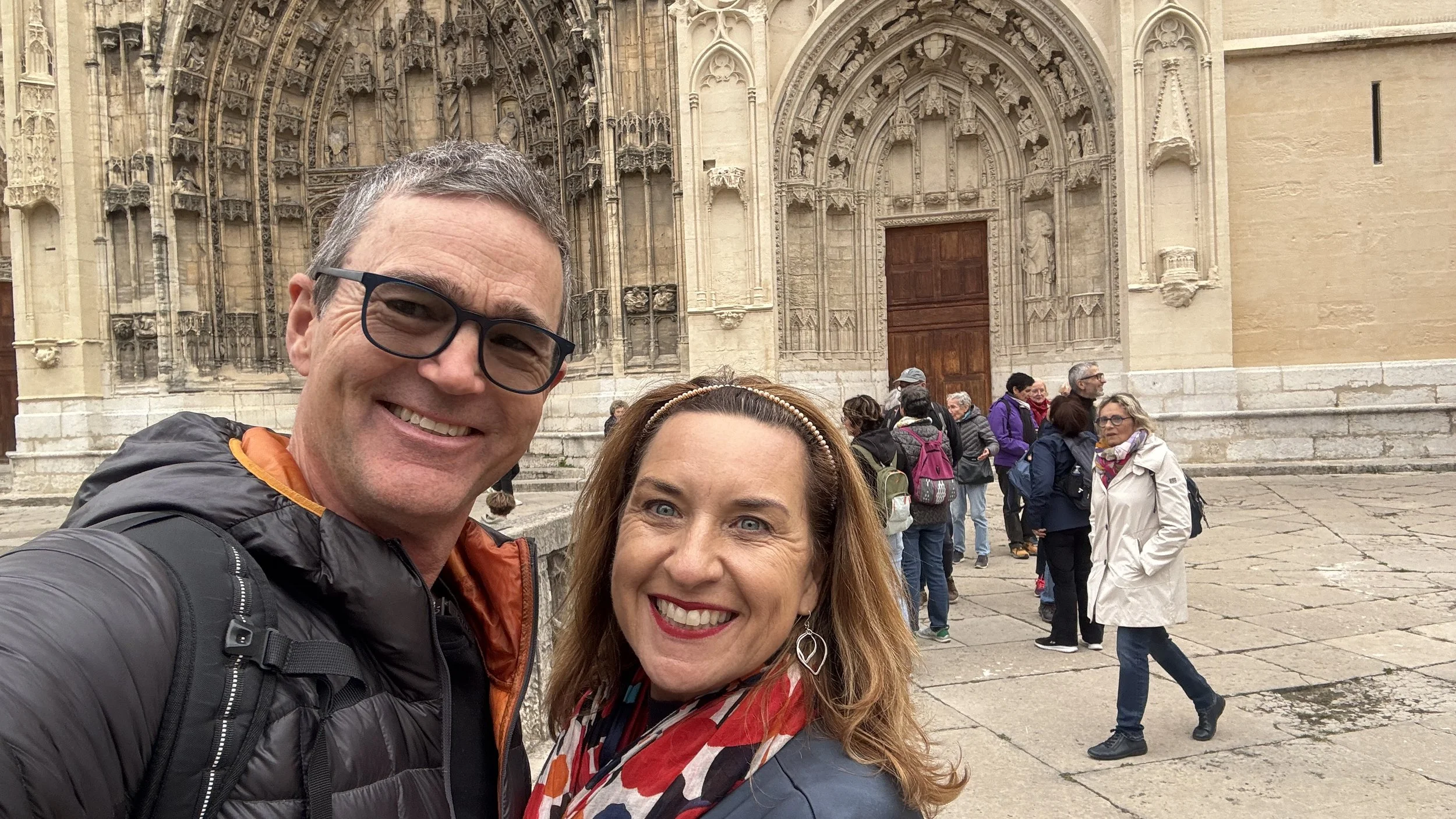Vienne, France (October 2025)
In front of the Musée gallo-romain Saint-Romain-en-Gal
Yesterday we made a day trip from Lyon to Vienne, France and really enjoyed the day. Just 18 minutes by train from Lyon’s Gare Part Dieu (and 30 minutes from Lyon’s Gare Jean-Macé…more about this later), Vienne is a fascinating day trip, especially if you are looking for another layer of history beyond the Gothic and Renaissance.
If you are a cycling fan, the name might be familiar since Tour de France cyclists rode through it on Stage 9 of the 2025 men’s race.
Originally a Gallic settlement of the Allobroges tribe, it became a Roman colony in the 1st century BCE and flourished as a commercial and cultural center on the Rhône River. 2,000 years ago, as a Gallo-Roman city, it was one of the most important towns in Roman Gaul.
We had to look up the difference between Roman and Gallo Roman and learned that Roman refers to things that originated directly from Rome and the Roman Empire. Gallo-Roman, on the other hand, describes the blend of Roman and local Gallic (Celtic) traditions that developed in what is now France after the Romans conquered the region.
Don’t worry…there’s only a little bit of history in this post. Just enjoy the walking tour and sites as we explored this charming historical town.
Some of my favorite pieces from the Beax-Arts museum
We took the 9:20 AM TER train from Lyon which deposited us at 9:38 AM at the only station in Vienne, a few blocks from the center of town. Our first stop of the day was for coffee (and a bathroom) before we began to leisurely check off the places on my list.
I found in Strasbourg and Alsace, that many places close for lunch sometime between the hours of 12 and 2:30 PM. Vienne was no different so we started with the petit Musée des Beaux-Arts et d’Archéologie de Vienne.
While the ticket guy tried to be very helpful in asking if we were over 65 to get the discount (ouch!), and provided us with a map of Vienne circling the 4 museums included in the $9 (for two), he made the Vienne museum ticket more complicated than it needed to be. He made sure (in French) that we provided the ticket to the Gallo-Romain museum for a reduced rate. Merci, Monsieur!
Once he was done explaining all of the options, he turned on the lights, and the projector for the history movie, and told us to enjoy ourselves. We were the first and only ones in there.
Not knowing the size of the museum, I sat down to watch (in French) the history of Vienne and it was informative. Fortunately it had French captions because I can read French better than I can comprehend it by ear. I understood about 65% of what I read, without enough time to look up unfamiliar words. I got the gist of it.
Meanwhile, Zeke wandered through and then waited the 10 minutes while I walked through the two rooms, took some pictures, appreciated a few items, and we left. Total time in the museum, including the longwinded explanation: <30 minutes.
Temple d’Auguste et Livie
We consulted the map and timetable, and walked the cobblestone streets to Place Charles de Gaulle to see the Temple d’Auguste et Livie, which once stood in the center of the heart of Roman Vienne’s forum. It’s stunning to have this ancient relic in such great condition, surrounded by modern, French shops, parking spaces, and cafes.
Next to the temple, is a modern sculpture of what we thought was a dog but based on my research, it may in fact be a cow (but not the Yoplait cow that was installed in protest against Yoplait’s pricing).
Zeke and Terri in the Musée-cloître Saint-André-le-Bas de Vienne
We continued to walk north on the narrow, cobblestone streets, laying bets as to whether the septuagenarian driving the little white Clio with his wife, was going to back up his way through the entire town. After we saw him for the third time on yet another street, still going in reverse, we decided to follow them to see where they actually ended up. Despite going slower than a walking pace, they lost us around a blind corner.
We didn’t have time for these kinds of distractions as we window shopped our way to Musée-cloître Saint-André-le-Bas de Vienne. At first we walked into the wrong museum which seemed to be located at the base of the Saint-André-le-Bas church and lovely woman inside directed us next door to the equally empty cloister.
I love a good cloister, especially when we have it to ourselves. Gotta love shoulder season! I was fascinated by the stone work (which you will see in a future video). This is the last complete Romanesque cloister remaining in the Rhône-Alpes region. Founded as early as the 6th or 7th century, it was part of the Abbaye de Saint-André-le-Bas. It was amazing to see the apartment building built right up against it. Time: <15 minutes
Jardin archéologique de Cybèle
Vienne has been investing quite a bit in renovations of its multi-layered history to bring people to Vienne and it shows. The Jardin archéologique de Cybèle was incredible. As we walked toward one of the three lunch spots Zeke found, we casually walked through this glorious space. It was great fun to see the middle / high school kids being kids while eating their lunch among ancient, Gallo-Roman ruins, because, you know, that’s what you do in Vienne.
Théâtre antique de Vienne
After a lovely lunch (we love a good entrée / plat and plat / dessert option) we continued up the hill toward Belvédère de Pipet, stopping at the Théâtre antique de Vienne (also included in our museum pass and which had reopened after lunch). This incredible theater was built around 40–50 AD (1st century BCE), during the early Roman period, and originally accommodated up to 13,000 spectators.
After the decline of Roman rule, the theatre fell into disuse, suffered damage, and was partially buried or built over in the medieval and modern eras, only to be rediscovered and excavated in the early 20th century. It reopened in 1938, and between 2018 and 2020, as part of Vienne’s major restoration plans as part of Plan Patrimoine (Heritage Plan), it was further renovated/upgraded and now holds about 8,000 people for performances, including Vienne’s annual jazz festival.
Once again, we encountered high school kids, this time on a field trip, and we couldn’t help but compare to our childhood field trips when we went to Sutter’s Mill in the Gold Country to see reenactments from the 1850s. It just doesn’t compare. Time: <30 minutes
View from the Belvédère de Pipet
We walked up, and up, and up, until we reached the Belvédère de Pipet, which provided a panoramic view of the Rhône River, and the surrounding hills.
After looking at the view, we turned around and saw the Monument aux Morts de Vienne, a war memorial honoring soldiers who died in World War I (we also saw a mural dedicated to them and listing the names at the train station). We often stop to appreciate these memorials throughout France and this day was no different.
Cemetery near the Belvédère de Pipet
Next to the monument is Église Notre-Dame-de-la-Salette, a small 19th-century church (built in the 1850s). We spent a few minutes alone in the church appreciating the stained glass and architecture before making our way back down the hill, passing the local cemetery along the way. My knee was much happier going up hill than down as we worked our way toward the Église Saint-André-le-Haut, another landmark on the map. We could only see the facade since it is now a school.
Our next stop was back to the Église Saint-André-le-Bas which we were told would be open after 2:30 or 3…it wasn’t. Strike 2 with churches…Zeke was not unhappy. He likes partially closed museums and completely closed churches.
Musée et sites gallo-romains de Saint-Romain-en-Gal
After the second church visit failure, we walked across the Rhône River to the Musée et sites gallo-romains de Saint-Romain-en-Gal. OMG! This place was amazing. After a quick walk through the beautiful modern building housing extraordinary historical finds, Zeke sat on a bench and read while I wiped the drool off my chin and picked it up off the floor at regular intervals.
I love mosaics and this place was filled with them! Zeke loves the story behind the find. In 1967 when they were excavating to prepare for the construction of a high school, they discovered (and uncovered) a large Gallo-Roman district with homes, workshops, and baths belonging to the ancient city of Vienna (Vienne).
I listened to the audioguide and learned they’d unearthed something like 250 mosaics. They have partially reconstructed floors and rooms to demonstrate what life was like in Gallo-Roman times. They have fully reconstructed mosaics as well that can be seen both from the main floor and catwalks on the second floor. It was extraordinary and I had trouble absorbing all that I was seeing.
There was another school group (middle schoolers?) walking through and one dared to try to take a tile from a wall and I scolded him from above on the catwalk. Kids will be kids, regardless of the country!
Outside, they had the roads laid out and marked so you could walk the neighborhood. It too was extraordinary. Zeke was happy to be outside and he knew we were on our way to our last stop of the day.
In front of Cathédrale Saint-Maurice de Vienne
Our final stop before the train station was Cathédrale Saint-Maurice de Vienne. Construction began around 1052 and continued for nearly 500 years, evolving from Romanesque to Gothic style as each generation influenced the design and construction.
What I found most fascinating historically about this absolutely gorgeous church, is its involvement with the Knights of Templar in the 14th century. I’ve been listening to the podcast Villains and Virgins and Eva did a series on the Knights of Templar so now I have to go back and re-listen.
This is what we love about our travels…history comes to life. We can read about it in a book or listen to a podcast but it’s often hard to make sense of all of the centuries, names, and places. For us, being there makes it relevant.
At this point, it was 5 PM and we’d checked off everything on my list and we were ready to be back in Lyon. As we were walking, I booked our return tickets back not realizing that there are four different train stations in Lyon. When I put Part Dieu into the search, I didn’t realize that it only gave me options for other stations. I selected the one that left at 5:36 and didn’t think anything of it until we got to the station and looked for our train and the platform.
That was when I realized that I’d selected Gare Jean-Macé. There were no options for Part Dieu. While on the train, we researched how to get to our neighborhood. Zeke’s feet were tired and we wanted the fastest route, including taking a Bolt or an Uber.
Ultimately, we got off at our stop, walked about 2 minutes to the C5 bus that was waiting for us. We got off near a C13 stop we’ve taken before, walked about a minute, and caught a bus within two minutes. It was awesome! We love European public transportation (when folks aren’t on strike!).
In Lyon, you can tap your credit card…you' don’t even need a separate app. And, if you use the same card (or your phone with Apple Pay), it will aggregate the costs at the end of the day to make sure you don’t pay more than the maximum. Very cool! But with two of us, we have to use two separate credit cards.
Stats at the end of the day:
Steps: 18K. Miles: 7.25. Flights of stairs: 32. Trains: 2. Buses: 3.
Costs:
Trains (out 1st class; return 2nd class) and buses: $60.25
Coffee / Lunch: $67.46
Museums: $23.03
Postcards for the kids: $2
Total for the day: $152,74
Summary of Places:
Musée des Beaux-Arts et d’Archéologie de Vienne
Temple d’Auguste et de Livie (free)
Cloître Saint-André-le-Bas
Jardin archéologique de Cybèle (free)
Théâtre antique de Vienne
Belvédère de Pipet (with Église Notre-Dame-de-la-Salette and the Monument aux Morts) (free)
Église Saint-André-le-Haut (facade only)
Église Saint-André-le-Bas (wasn’t open)
Musée et sites gallo-romains de Saint-Romain-en-Gal
Cathédrale Saint-Maurice de Vienne (free)

